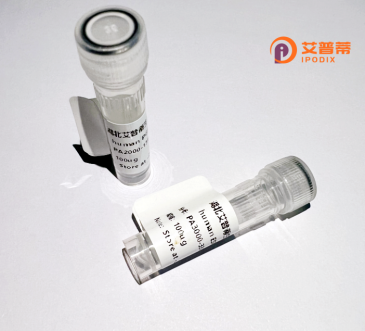
| 纯度 | >90%SDS-PAGE. |
| 种属 | Human |
| 靶点 | WDR4 |
| Uniprot No | P57081 |
| 内毒素 | < 0.01EU/μg |
| 表达宿主 | E.coli |
| 表达区间 | 2-412 aa |
| 活性数据 | AGSVGLALCGQTLVVRGGSRFLATSIASSDDDSLFIYDCSAAEKKSQENKGEDAPLDQGS GAILASTFSKSGSYFALTDDSKRLILFRTKPWQCLSVRTVARRCTALTFIASEEKVLVAD KSGDVYSFSVLEPHGCGRLELGHLSMLLDVAVSPDDRFILTADRDEKIRVSWAAAPHSIE SFCLGHTEFVSRISVVPTQPGLLLSSSGDGTLRLWEYRSGRQLHCCHLASLQELVDPQAP QKFAASRIAFWCQENCVALLCDGTPVVYIFQLDARRQQLVYRQQLAFQHQVWDVAFEETQ GLWVLQDCQEAPLVLYRPVGDQWQSVPESTVLKKVSGVLRGNWAMLEGSAGADASFSSLY KATFDNVTSYLKKKEERLQQQLEKKQRRRSPPPGPDGHAKKMRPGEATLSC |
| 分子量 | 45.4 kDa |
| 蛋白标签 | His tag N-Terminus |
| 缓冲液 | PBS, pH7.4, containing 0.01% SKL, 1mM DTT, 5% Trehalose and Proclin300. |
| 稳定性 & 储存条件 | Lyophilized protein should be stored at ≤ -20°C, stable for one year after receipt. Reconstituted protein solution can be stored at 2-8°C for 2-7 days. Aliquots of reconstituted samples are stable at ≤ -20°C for 3 months. |
| 复溶 | Always centrifuge tubes before opening.Do not mix by vortex or pipetting. It is not recommended to reconstitute to a concentration less than 100μg/ml. Dissolve the lyophilized protein in distilled water. Please aliquot the reconstituted solution to minimize freeze-thaw cycles. |
1. **"WDR4 mediates tRNA m7G46 modification and regulates homeostasis of human embryonic stem cells"**
*Authors: Chen, T., et al.*
摘要:该研究揭示了重组人WDR4蛋白在tRNA m7G46甲基化修饰中的核心作用,并证明其通过调控翻译效率影响人胚胎干细胞的自我更新与分化平衡。
2. **"Structural basis of tRNA recognition by WDR4 in m7G methylation"**
*Authors: Lin, S., et al.*
摘要:通过晶体结构解析,阐明了重组WDR4蛋白与tRNA及甲基转移酶复合体的相互作用机制,揭示了WD40结构域介导底物识别的分子基础。
3. **"WDR4 promotes hepatocellular carcinoma progression via stabilizing EGFR signaling"**
*Authors: Wang, Y., et al.*
摘要:研究发现重组WDR4在肝癌中异常高表达,通过稳定EGFR信号通路促进肿瘤侵袭,其敲除显著抑制小鼠模型中肿瘤生长。
4. **"Recombinant WDR4 protein purification and its functional analysis in DNA damage response"**
*Authors: Gupta, R., et al.*
摘要:报道了重组WDR4蛋白的高效表达与纯化策略,并发现其参与ATM/ATR通路调控,影响细胞在DNA损伤后的周期停滞与修复过程。
**Background of Recombinant Human WDR4 Protein**
WD repeat domain 4 (WDR4) is a member of the WD-repeat protein family, characterized by conserved tandem repeats of ~40 amino acids terminating with tryptophan-aspartic acid (WD) motifs. These proteins typically act as scaffolds for multi-protein complexes, facilitating diverse cellular processes. WDR4. specifically, plays a critical role in tRNA modification by forming part of the tRNA m7G methylation complex. It interacts with METTL1. catalyzing the addition of a methyl group to the N7 position of guanine (m7G) at position 46 in tRNAs, a modification essential for tRNA stability, translation fidelity, and efficient protein synthesis.
Dysregulation of WDR4 has been linked to human diseases. For instance, mutations in *WDR4* are associated with microcephaly, developmental disorders, and cancer, including glioblastoma and hepatocellular carcinoma. Overexpression of WDR4 is observed in some malignancies, promoting cell proliferation and metastasis, likely through enhancing translation efficiency of oncogenic mRNAs.
Recombinant human WDR4 protein, produced via expression systems like *E. coli* or mammalian cells, retains native structure and function. It serves as a vital tool for studying tRNA modification mechanisms, ribosome biogenesis, and disease pathways. Researchers utilize it in biochemical assays (e.g., methylation activity studies), protein interaction analyses, and drug screening to identify potential inhibitors targeting WDR4-associated pathologies. Its study may unravel novel therapeutic strategies for cancers and genetic disorders tied to tRNA dysregulation.
×